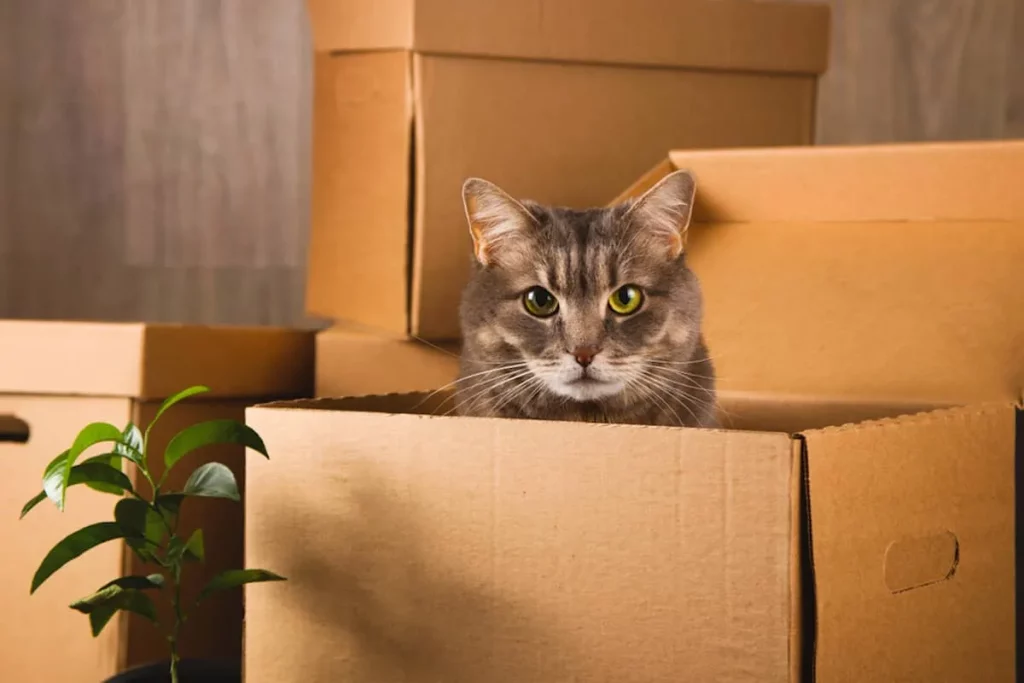Embarking on a long-distance move can be a thrilling adventure, filled with new opportunities and experiences waiting at the destination. However, for pet owners, especially those with feline companions, the prospect of moving can also bring about concerns and challenges. ‘How to move with a cat long distance‘ becomes a pivotal question, encompassing not just the logistics of packing and transporting belongings but also ensuring the comfort, safety, and well-being of a beloved pet. In this guide, we navigate the intricacies of relocating with a cat over a considerable distance, offering practical tips, expert advice, and compassionate insights to make the journey as smooth and stress-free as possible for both feline and human companions.

Tips for Moving a Cat Long Distance
Start with a Paws-itive Plan
Long-distance moves require careful planning, especially when you have a cat in tow. Begin by creating a comprehensive moving plan that includes all the necessary arrangements for your pet. Determine your travel route, accommodations, and any pet-friendly stops along the way. Research pet policies for airlines or hotels if you’re flying or staying overnight. Having a clear plan in place will help alleviate stress and ensure a smoother experience for you and your cat.
Get Your Cat Comfortable with the Cat Carrier
Most cats aren’t fond of carriers, but with a bit of patience and positive reinforcement, you can help your feline friend see it as a safe space. Start by introducing the carrier well in advance of your move. Leave it open in a familiar area with comfy bedding and treats inside. Encourage your cat to explore and spend time in the carrier voluntarily. Gradually increase the time spent inside, rewarding calm behavior with treats and praise. By making the carrier a familiar and positive space, your cat will be less stressed during travel.
Schedule a Vet Check-Up
Before hitting the road, schedule a visit to the vet for a thorough check-up and to ensure your cat is up-to-date on vaccinations and medications. Your vet can also provide valuable advice on managing stress and motion sickness during travel. If your cat is prone to anxiety or motion sickness, your vet may recommend medications or supplements to help keep them calm and comfortable during the journey. Don’t forget to refill any prescription medications and pack a copy of your cat’s medical records for emergencies.
Pack a Purr-sonalized Travel Kit
Just like you, your cat needs their own travel essentials for the journey ahead. Pack a travel kit with items such as:
- Food and water bowls
- Portable litter box and litter
- Enough food for the duration of the trip
- Favorite toys or comfort items
- Blankets or bedding with familiar scents
- Leash and harness for pit stops
Having these familiar items on hand will provide comfort and security for your cat throughout the move.
Make Overnight Stays Pet-Friendly
If your move requires overnight stays at hotels or accommodations along the way, be sure to book pet-friendly options in advance. Many hotels and motels welcome furry guests for an additional fee. When making reservations, inquire about pet policies, fees, and any restrictions. Choose accommodations with amenities like outdoor areas or nearby parks for your cat to stretch their legs and relieve themselves. Remember to supervise your cat at all times and respect the property rules to ensure a pleasant stay for everyone.
Practice Safe Travel Precautions
Whether you’re traveling by car or plane, it’s essential to prioritize your cat’s safety during the journey. If you’re driving, secure your cat in a well-ventilated carrier using a seatbelt or harness to prevent injury in case of sudden stops or accidents. Never leave your cat unattended in a parked car, especially in hot or cold weather. If flying, opt for a direct flight whenever possible to minimize stress and reduce travel time. Follow airline guidelines for pet travel and ensure your cat meets all size and health requirements.
Monitor Your Cat’s Behavior
During the move, pay close attention to your cat’s behavior and well-being. Cats are sensitive creatures, and changes in their environment can cause stress and anxiety. Look out for signs of distress such as excessive meowing, pacing, hiding, or refusal to eat or use the litter box. Comfort your cat with gentle words, cuddles, and familiar scents to help them feel safe and secure. If your cat exhibits concerning symptoms or behaviors, don’t hesitate to seek advice from a veterinarian.
Settling into Your New Home
Congratulations, you’ve made it to your new home sweet home! But before you start unpacking, take some time to create a safe and comfortable space for your cat. Set up their food and water bowls, litter box, and bedding in a quiet area away from the hustle and bustle of moving boxes. Allow your cat to explore their new surroundings at their own pace, gradually introducing them to different rooms and areas of the house. Provide plenty of love, attention, and familiar comforts to help ease the transition.
Establish Routine and Familiarity
Cats thrive on routine and familiarity, so try to maintain as much consistency as possible during the moving process. Stick to your cat’s regular feeding schedule, playtime, and bedtime routines to provide a sense of stability and security. Spend quality time bonding with your cat in your new home, engaging in activities they enjoy, and creating positive associations with their new environment. With time and patience, your cat will adjust to their new surroundings and feel right at home.
Patience is Key
Moving long distances with a cat can be challenging, but remember to be patient and understanding throughout the process. Your cat may need some time to adjust to the changes and may exhibit behaviors that are out of character. Offer reassurance, love, and plenty of TLC as your furry friend acclimates to their new home. With patience, understanding, and a whole lot of love, you and your cat will navigate the journey together and create new memories in your exciting adventure ahead.
Conclusion
In conclusion, embarking on a long distance move with a cat may seem like a daunting task, but with the right preparation and mindset, it can be a rewarding journey for both you and your furry friend. By following the tips and guidelines outlined in this guide, you can ensure a smooth and stress-free transition for your cat, making them feel safe, comfortable, and loved every step of the way. Remember, moving with a cat requires patience, understanding, and a whole lot of love, but the bond you’ll share as you navigate this adventure together will make it all worthwhile. So, embrace the challenges, cherish the moments, and embark on your How to Move With a Cat Long Distance with confidence, knowing that you and your feline companion are ready for whatever the road ahead may bring. Here’s to new beginnings, unforgettable adventures, and the purr-fect journey ahead!
Ready to tackle the challenge of a long-distance move with your beloved feline companion? Say goodbye to the stress and hello to a seamless transition with Gorilla Moving Company by your side. Our experienced team understands the unique needs of moving with pets and will ensure a purr-fect journey for both you and your furry friend. Contact us today to make your How to Move With a Cat Long Distance experience a breeze!
Want to know about: “How Much Does It Cost to Move From Toronto to Mission BC?” Visit our blog page today to get the best moving tips for your long-distance move!
FAQs: How to Move With a Cat Long Distance
Is it safe to fly with my cat for a long-distance move?
Yes, it’s generally safe to fly with your cat, but it’s essential to research airline policies, choose a pet-friendly carrier, and consult with your vet beforehand to ensure your cat’s comfort and safety during the journey.
How can I help my cat adjust to a new home after a long-distance move?
To help your cat settle into their new environment, create a designated safe space with familiar items, maintain their routine as much as possible, and provide plenty of love, attention, and reassurance as they acclimate to their new surroundings.
What should I do if my cat becomes anxious during the move?
If your cat experiences anxiety or stress during the move, try to remain calm and provide comfort with gentle words, cuddles, and familiar scents. You can also consult with your vet about possible calming solutions or medications to help ease your cat’s nerves.
How do I ensure my cat’s safety during a long-distance road trip?
To ensure your cat’s safety during a road trip, secure them in a well-ventilated carrier with a seatbelt or harness to prevent injury in case of sudden stops or accidents. Make frequent pit stops to allow your cat to stretch their legs, use the litter box, and stay hydrated.
What documents do I need to travel with my cat long distance?
When traveling long distances with your cat, be sure to have a copy of their up-to-date medical records, including vaccination certificates and proof of identification. If flying, check airline requirements for pet travel and obtain any necessary permits or health certificates.








